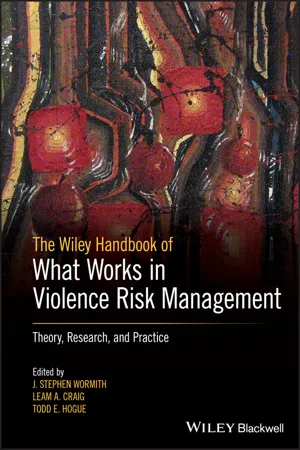1
An Overview of Violent Behaviour from Aggression to Homicide: Theory, Research, and Practice
J. Stephen Wormith1, Leam A. Craig2,3,4, and Todd E. Hogue5
1 University of Saskatchewan, Canada
2 Forensic Psychology Practic Ltd., Sutton Coldfield, UK
3 Centre for Applied Psychology, University of Birmingham, UK
4 School of Social Sciences, Birmingham City University, UK
5 School of Psychology, University of Lincoln, UK
Introduction and Overview
The magnitude and scope of human violence is vast and its manifestations take many forms. As such, it remains one of the terrible ills with which our species must contend. Arguably, it remains as complex and resistant to amelioration as fatal medical conditions such as cancer and ‘super bugs’, chronic economic issues such as poverty, hunger, and homelessness, and political blights such as warfare, displaced refugees, and ethnic cleansing. Violence, by definition, always has an impact on individuals and often extends to the broader community and society as a whole. Consequently, society has a tremendous responsibility to address violence and to challenge both its causes and its perpetrators. However, the diversity of forms by which violence is enacted dictate that our range of responses must be equally diverse. Social sciences and their allied professions offer a number of important strategies to address violence by furthering theories of violence, generating empirical data about violence, and translating the resulting knowledge into policy and practice. But when it comes to violence, the devil is, quite literally, in the details.
This chapter offers an overview of violence in society and the complex issues that it raises for researchers, clinicians, policy makers, lawmakers, and society at large. It begins with a review of definitions of violence, then describes its behavioural variability, and relates violence to other forms of antisocial behaviour, such as aggression. While being mindful not to burden the reader with endless statistics, it offers sobering data about the magnitude of violence in society and its impact on victims, with a focus on its most severe expression, homicide. Attention is given to some of the more popular and validated theories of violence as they may guide efforts to reduce the prevalence of violence in society and to direct further research. In order to be successful, such efforts must use empirically validated assessments, the dramatic proliferation of which is described briefly. This leads to a review of explicit efforts to reduce violence presented in three tiers whereby the criminological concepts of primary, secondary, and tertiary prevention are used to classify violence prevention initiatives (Pease 2002). The chapter ends with a call to arms on many fronts and points to the remaining chapters as a series of promising jumping off points.
Definitions of Violence and Aggression
Because of its diverse forms, a comprehensive, all‐inclusive definition of violence is more difficult to craft than one might anticipate. Moreover, disciplines and professions are likely to conceptualize violence in a fashion that reflects their own perspective of human behaviour. It is also important to understand the difference between violence and aggression and to appreciate how the former is situated within the latter, which itself, also requires some thought to define.
There are two key aspects to the concept of aggression. The first is that it entails a conscious effort to harm someone or some people. The second is that the nature of the intended harm can take various forms including physical, emotional, and psychological. Although implied in Glover's (1960) psychoanalytic perspective on crime, Feshbach (1964) was the first to identify two types of aggression that are based on the motivation of the perpetrator and are expressed in two distinct manners. Although various terms have been used over the last half century, the first form of aggression (described as hostile, irritable, reactive, expressive, and conflict‐oriented aggression) entails a reaction to some kind of external event, often a slight, insult, or perceived transgression or act of unfairness that generates an emotional, often impulsive and disorganized, reaction to the triggering event. On the other hand, the second form of aggression (described as instrumental, predatory, proactive, purposive, premeditated, and crime‐oriented aggression), is motivated by a desire to achieve some specific goal, often the acquisition of material gain, but can also be motivated simply by a desire to inflict some suffering on another individual. It is planned, premeditated, organized, and can take quite some time to orchestrate. In addition, the magnitude of each motivational dimension can vary tremendously, from a verbal insult to a murderous rage and from hurt feelings to the fraudulent acquisition of one's life savings.
In spite of the variation of severity within these two kinds of aggression, empirical examples of their differences abound. Khachatryan et al. (2018) revealed that crime‐oriented juvenile homicide was much more likely to involve accomplices (86%) than conflict‐oriented crime (37.5%), while conflict‐oriented homicide was much more likely to involve firearms (75% vs. 39.5%). Also amongst juvenile offenders, Tecce (2014) found that those who committed instrumental aggression had significantly higher psychopathy scores than those who committed reactive aggression. In the laboratory, alcohol is more likely to increase reactive aggression in persons with higher hostile rumination scores, but not with persons with lower hostile rumination scores (Borders and Giancola 2011). Amongst intimate partner violence (IPV) offenders, instrumental aggressors were significantly more likely to have previously assaulted a family member (33% vs. 15%) and to hold attitudes that condone spousal assault (20% vs. 7%), while reactive aggressors were significantly more likely to have witnessed or been a victim of family violence during their childhood (29% vs. 11%; Ennis et al. 2017). Treatment, such as anger management, has been found to affect violent offenders' potential for reactive aggression, but not proactive aggression (Walters 2009). In a sample of violent offenders in Ontario, Canada, t...
